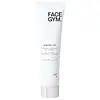What's inside
What's inside
 Key Ingredients
Key Ingredients

No key ingredients
 Benefits
Benefits

 Concerns
Concerns

 Ingredients Side-by-side
Ingredients Side-by-side

Water
Skin ConditioningGlycerin
HumectantGlycolipids
Skin ConditioningHectorite
AbsorbentPropanediol
SolventSodium Cocoyl Apple Amino Acids
Skin ConditioningBetaine
HumectantIsopentyldiol
HumectantDisodium Cocoyl Glutamate
CleansingPapain
Skin ConditioningHordeum Distichon Extract
Skin ProtectingMelissa Officinalis Leaf Extract
Skin ConditioningTrifolium Pratense Flower Extract
AstringentCarrageenan
Coco-Glucoside
CleansingGlyceryl Oleate
EmollientXanthan Gum
EmulsifyingHexylene Glycol
EmulsifyingCalcium PCA
HumectantMagnesium PCA
HumectantTetrasodium Glutamate Diacetate
1,2-Hexanediol
Skin ConditioningCaprylyl Glycol
EmollientCarbomer
Emulsion StabilisingAlgin
MaskingDisodium Rutinyl Disulfate
AntioxidantTocopherol
AntioxidantHydrogenated Vegetable Glycerides Citrate
EmollientPhenoxyethanol
PreservativeHydroxyacetophenone
AntioxidantSodium Benzoate
MaskingCitric Acid
BufferingWater, Glycerin, Glycolipids, Hectorite, Propanediol, Sodium Cocoyl Apple Amino Acids, Betaine, Isopentyldiol, Disodium Cocoyl Glutamate, Papain, Hordeum Distichon Extract, Melissa Officinalis Leaf Extract, Trifolium Pratense Flower Extract, Carrageenan, Coco-Glucoside, Glyceryl Oleate, Xanthan Gum, Hexylene Glycol, Calcium PCA, Magnesium PCA, Tetrasodium Glutamate Diacetate, 1,2-Hexanediol, Caprylyl Glycol, Carbomer, Algin, Disodium Rutinyl Disulfate, Tocopherol, Hydrogenated Vegetable Glycerides Citrate, Phenoxyethanol, Hydroxyacetophenone, Sodium Benzoate, Citric Acid
Water
Skin ConditioningSodium Cocoyl Glycinate
CleansingCoco-Betaine
CleansingGlycerin
HumectantAcrylates Copolymer
Sodium Chloride
MaskingPhenoxyethanol
PreservativeCitrus Limon Peel Oil
MaskingLimonene
PerfumingSodium Hydroxide
BufferingTetrasodium EDTA
Propylene Glycol
HumectantGeranium Maculatum Oil
MaskingCitral
PerfumingCalendula Officinalis Flower Extract
MaskingCymbopogon Schoenanthus Oil
MaskingArtemisia Absinthium Extract
Skin ConditioningCitric Acid
BufferingWater, Sodium Cocoyl Glycinate, Coco-Betaine, Glycerin, Acrylates Copolymer, Sodium Chloride, Phenoxyethanol, Citrus Limon Peel Oil, Limonene, Sodium Hydroxide, Tetrasodium EDTA, Propylene Glycol, Geranium Maculatum Oil, Citral, Calendula Officinalis Flower Extract, Cymbopogon Schoenanthus Oil, Artemisia Absinthium Extract, Citric Acid
 Reviews
Reviews

Ingredients Explained
These ingredients are found in both products.
Ingredients higher up in an ingredient list are typically present in a larger amount.
Citric Acid is an alpha hydroxy acid (AHA) naturally found in citrus fruits like oranges, lemons, and limes.
Like other AHAs, citric acid can exfoliate skin by breaking down the bonds that hold dead skin cells together. This helps reveal smoother and brighter skin underneath.
However, this exfoliating effect only happens at high concentrations (20%) which can be hard to find in cosmetic products.
Due to this, citric acid is usually included in small amounts as a pH adjuster. This helps keep products slightly more acidic and compatible with skin's natural pH.
In skincare formulas, citric acid can:
While it can provide some skin benefits, research shows lactic acid and glycolic acid are generally more effective and less irritating exfoliants.
Most citric acid used in skincare today is made by fermenting sugars (usually from molasses). This synthetic version is identical to the natural citrus form but easier to stabilize and use in formulations.
Read more about some other popular AHA's here:
Learn more about Citric AcidGlycerin is already naturally found in your skin. It helps moisturize and protect your skin.
A study from 2016 found glycerin to be more effective as a humectant than AHAs and hyaluronic acid.
As a humectant, it helps the skin stay hydrated by pulling moisture to your skin. The low molecular weight of glycerin allows it to pull moisture into the deeper layers of your skin.
Hydrated skin improves your skin barrier; Your skin barrier helps protect against irritants and bacteria.
Glycerin has also been found to have antimicrobial and antiviral properties. Due to these properties, glycerin is often used in wound and burn treatments.
In cosmetics, glycerin is usually derived from plants such as soybean or palm. However, it can also be sourced from animals, such as tallow or animal fat.
This ingredient is organic, colorless, odorless, and non-toxic.
Glycerin is the name for this ingredient in American English. British English uses Glycerol/Glycerine.
Learn more about GlycerinPhenoxyethanol is a preservative that has germicide, antimicrobial, and aromatic properties. Studies show that phenoxyethanol can prevent microbial growth. By itself, it has a scent that is similar to that of a rose.
It's often used in formulations along with Caprylyl Glycol to preserve the shelf life of products.
Water. It's the most common cosmetic ingredient of all. You'll usually see it at the top of ingredient lists, meaning that it makes up the largest part of the product.
So why is it so popular? Water most often acts as a solvent - this means that it helps dissolve other ingredients into the formulation.
You'll also recognize water as that liquid we all need to stay alive. If you see this, drink a glass of water. Stay hydrated!
Learn more about Water